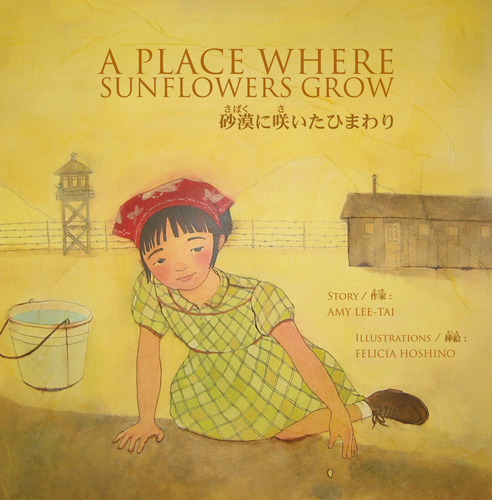A Place Where Sunflowers Grow (book)
Creators: Amy Lee-Tai, Felicia Hoshino
Children's picture book by Amy Lee-Tai and illustrated by Felicia Hoshino about Mari, a young Japanese American girl in Topaz , an American concentration camp during World War II. As the book begins, she plants sunflower seeds in the desert soil, hoping they will grow like the sunflowers in their old backyard. She recalls their prewar home, where she lived with her older brother and artist parents. At Topaz, she goes with her father to the art school he started. Initially unable to draw anything in the children's class, she slowly starts to find things to draw with the help of a supportive teacher, her father, and her new friend Aiko. After drawing a picture of her barrack with the sunflowers growing tall in front, she returns home to find little sunflower seedlings, giving her hope for the future. A final page provides biographies of the author and illustrator and some background on the book. The main text of the book is in both English and Japanese, the latter via translation by Marc Akio Lee.
Author Amy Lee-Tai is the granddaughter of artists George Matsusaburo and Hisako Hibi , who were incarcerated at Topaz and who did teach at the art school there. Her mother, Ibuki Hibi Lee, really did plant sunflower seeds at Topaz that eventually grew to be eight feet high. Though based on her family's story, the book is fiction. Artist Felicia Hoshino grew up in San Francisco and is the granddaughter of former inmates at Poston and Minidoka . Her illustrations for the book were made with watercolor, ink, tissue paper, and acrylic paint; some reference paintings by Hisako Hibi.
Children's Book Press also published a teacher's guide for Sunflowers that is available online. The guide was funded by a grant from the California Civil Liberties Public Education Program .
Reviews for A Place Where Sunflowers Grow were largely positive. Elizabeth Nolan and Roselmina Indrisano call it "a masterful accomplishment," while Fran Levin calls it "... a historical story that can inspire children to believe that hope and courage are present in all of us." [1] However Jennifer Mattson in Booklist found it didactic, with "a slightly wandering story line." [2] While Levin found the dual language element "an excellent feature," Publishers Weekly found that it "crowds the pages visually." [3]
Sunflowers won several awards, most notably the Jane Addams Children's Book Award, Books for Younger Readers in 2007.
Might also like: The Bracelet by Yoshiko Uchida; Fish for Jimmy by Katie Yamasaki; Blue Jay in the Desert by Marlene Shigekawa
Footnotes
- ↑ Elizabeth Nolan and Roselmina Indrisano, Journal of Education 196.1 (2016), 56; Fran Levin, "Encouraging Ethnic Respect Through Multicultural Literature," Reading Teacher 61.1 (Sept. 2007), 103.
- ↑ Jennifer Mattson, Booklist , Aug. 1, 2006, 90.
- ↑ Levin, "Encouraging Ethnic Respect"; Publishers Weekly , June 19, 2006, 62–63.
| Author | Amy Lee-Tai, Marc Akio Lee (Japanese translation) |
|---|---|
| Illustrator | Felicia Hoshino |
| Pages | 32 |
| Publication Date | 2006 |
| Awards | International Reading Association Notable Book, Primary Fiction, 2007 |
For More Information
Publisher website: https://www.leeandlow.com/books/2770
Teacher's guide: https://www.leeandlow.com/images/pdfs/A_Place_Where_Sunflowers_Grow.pdf
Reviews
Brangwin, Nelda. Library Media Connection , Feb. 2007, 69. ["The large format makes it a good book for group sharing. The artwork, which is based on that done by Lei-Tai's (sic) grandmother, helps capture the desolation of the camp."]
Bush, Elizabeth. Bulletin of the Center for Children's Books 60.2 (Oct. 2006): 81. ["This is a heartfelt tale, gently fashioned for young listeners, with words and pictures offering glimpses of daily life where sun blazed, dust storms blew, accommodations were primitive, and privacy was at a premium."]
Kirkus Reviews , July 15, 2006, 725. ["Hoshino's watercolor-and-mixed-media illustrations are golden, topaz-touched; their palette and composition hint of the classic nursery rhyme art of Jessie Wilcox Smith and others, aptly evoking the era they depict. A satisfying introduction and backmatter, including personal notes from the author and artist, acknowledgments and translation credits, make this a richly informative introduction to a subject little-addressed in works for children."]
Levin, Fran. "Encouraging Ethnic Respect Through Multicultural Literature." Reading Teacher 61.1 (Sept. 2007): 101–04. ["… a historical story that can inspire children to believe that hope and courage are present in all of us."]
Mattson, Jennifer. Booklist , Aug. 1, 2006, 90. ["The message feels a bit overt, and the slightly wandering story line may not hold every reader. Still, Hoshino's delicate mixed-media illustrations offer a wide-angle view of the daily lives of internees, and her buff-colored backdrops palpably convey the dusty, arid setting."]
Nolan, Elizabeth, and Roselmina Indrisao. Journal of Education 196.1 (2016): 55–56. ["... the characters portray the power of the human spirit to find hope and promise amidst challenges to their physical and emotional well being."]
Publishers Weekly , June 19, 2006, 62–63. ["Hoshino's ink-and-watercolor spreads both provide historical information and convey the story's emotional weight—and do both with grace."]
Taniguchi, Marilyn. School Library Journal , Sept., 2006, 177. ["Lee-Tai's tale, with its emphasis on the internees' dignity and feelings, offers the gentlest introduction to this tragic episode."]
